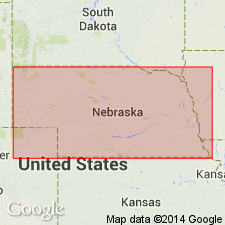
- Usage in publication:
-
- Stovall limestone member
- Modifications:
-
- Original reference
- Dominant lithology:
-
- Limestone
- AAPG geologic province:
-
- Nemaha anticline
- Sedgwick basin
Summary:
Stovall limestone. Basal member of Winfield formation of Chase group. Dark gray, granular, and quite fossiliferous. Is cherty from Nebraska to north of Winfield, Kansas, in a thickness increasing southward from 2+/- feet to 4 feet or more. It is noncherty at Winfield, beyond which it soon thins out southward, not reaching Arkansas City, Kansas. We have followed it from Winfield, Kansas, to Odell and Krider, Nebraska. Overlies Gage shale member of Doyle formation of Chase group and underlies Grant shale member of Winfield. Fossils (brachiopods PRODUCTUS and DERBYA, bryozoans RHOMBOPORA and SEPTOPORA, crinoid joints, echinoid spines). Age is Permian (Big Blue).
Type locality: in bluffs of Doyle Creek Valley southeast of Stovall elevator and farm, 7 mi southwest of Florence, Marion Co., eastern KS. Named from Stovall elevator and farm.
Source: US geologic names lexicon (USGS Bull. 896, p. 2073); GNC KS-NE Permian Corr. Chart, Oct. 1936; supplemental information from GNU records (USGS DDS-6; Denver GNULEX).
For more information, please contact Nancy Stamm, Geologic Names Committee Secretary.
Asterisk (*) indicates published by U.S. Geological Survey authors.
"No current usage" (†) implies that a name has been abandoned or has fallen into disuse. Former usage and, if known, replacement name given in parentheses ( ).
Slash (/) indicates name conflicts with nomenclatural guidelines (CSN, 1933; ACSN, 1961, 1970; NACSN, 1983, 2005, 2021). May be explained within brackets ([ ]).

